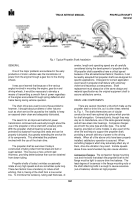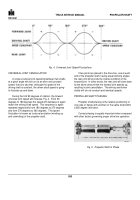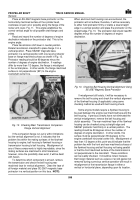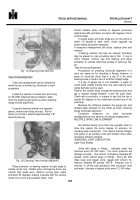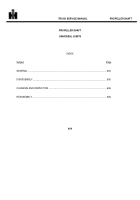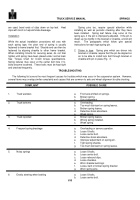TM-5-3805-254-14-P-2 - Page 608 of 894
TRUCK SERVICE MANUAL
PROPELLER SHAFT
General
Rear Axle Pinion Shaft Companion Flange
Horizontal Alignment
To check the horizontal alignment of the rear axle
pinion shaft companion flange, use lame procedure as
for checking main or auxiliary transmission flange.
An alternate method for checking pinion flange
horizontal alignment is by measuring the distance from
the ends of a straight edge placed across the frame to
the centers of the rear axle (distance "Y", Fig.
17).
These measurements may not vary more than 1/8".
Horizontal misalignment of the pinion flange can be
corrected by eliminating one or all of the possible
causes, which are:
1.
Loose or sheared spring seat dowels.
2.
Loose spring clips.
3.
Loose spring shackle brackets.
The rear axle pinion flange alignment can be
checked by the same method as the forward rear axle.
YOKE ALIGNMENT AND DISTORTION
Correct alignment of universal yokes is as important
as proper flange alignment.
Before checking their angle,
it is necessary to inspect the yoke for lug distortion or
damage.
The same standards of alignment, distortion
and runout apply to yokes.
As with a flange, a yoke can
often be revolved on its splined shaft to improve
concentricity.
Checking Yoke for Distortion and Run-Out
A straight piece of round bar stock which is a slip fit
in the two universal joint bearing bores can be used as a
gauge bar.
If the gauge bar is a slip fit through both
bearing bores simultaneously, the bores are properly
aligned, and the yoke is not distorted or damaged.
If the
bar goes through one bearing bore but strikes the inner
face of the opposite lug, the yoke is distorted and should
be replaced.
If a gauge bar of correct diameter is not available,
yoke distortion can be checked using a protractor.
Some
types of universal joints use a bearing cap separate from
the trunnion bearing retainer, while others have the cap
as an integral part of the bearing retainer.
When checking a yoke having a separate cap and
bearing retainer, remove the lock strap and cap.
Allow
the trunnion bearing retainer to protrude approximately
1/8" beyond the yoke lug. Rotate the yoke until the "C"
formed by the yoke is in a vertical position.
Place an SE-
2067
magnetic base protractor on the machined flat of the
upper or lower bearing retainer transversely with the
propeller shaft.
Turn yoke until protractor dial reads zero
degrees.
Without moving the yoke, place protractor on
the opposite bearing retainer.
If protractor readings differ
more than 1/2 degree, the yoke is probably distorted and
should be replaced.
If bearing retainer has been removed, place
protractor on machined flat of yoke.
If cap is an integral
part of bearing retainer, protractor may be placed on cap,
providing cap is flat.
If cap is dome shaped at all,
remove cap and retainer and place protractor on
machined flat of yoke.
All drive line yokes can be checked for distortion
using either the bar stock or protractor, Fig.
18.
Back to Top

